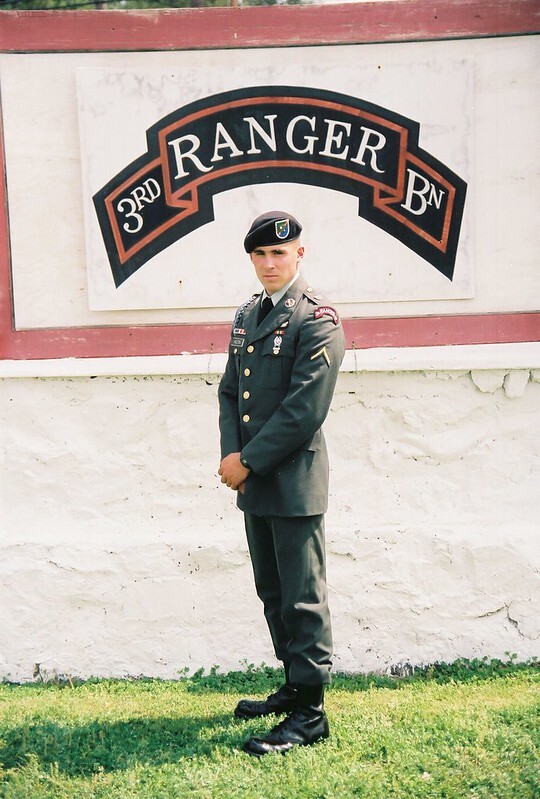I went to Ukraine to see if Ukraine is crumbling under the pressure from Russia or if they are holding their own. The people on the frontline suffer from drones attacking civilians and missiles striking every day, and the people want an end to the war that won't end with them under the rule of Russia. Because if that happens, the Ukrainians will be wiped out completely.

Today’s military is not what it once was. If you’re interested in joining, you should go in with your eyes open and be spiritually fit and firm in your beliefs. The military has become, in many ways, a grand social experiment. There’s a lot of social engineering going on these days, and if you’re not prepared, that kind of environment can throw you off course fast. My advice? If you’re grounded, disciplined, and willing to embrace the hardships, the military can still offer you something valuable. But make no mistake—it’s a different beast from what I joined in the late ‘80s. Here’s what I learned in my time in the Army Rangers, along with some hard-earned advice if you’re thinking about enlisting.
1. Start with Mental Toughness—and a Strong Spiritual Foundation
The military has always required grit, but in today’s military, it’s about more than physical or mental toughness; you’ll need a solid grasp of your values to stay the course. Back in Ranger training, we faced brutal, relentless conditions—weeks in the field, little sleep, no luxuries. We were there to be hardened, and we knew what we were signing up for. Now, you’ll still face those physical and mental tests, but you’ll also have to navigate a different kind of pressure, one that involves balancing your values with what can sometimes feel like arbitrary social experiments.
For young men considering enlisting, my advice is to establish a firm foundation in your faith and your worldview. Programs like the International ALERT Academy can give you a foundation rooted in discipline and biblical values. You don’t want to join only to find yourself swayed by the “social engineering” agenda they’re pushing. Get grounded now; it will help you hold the line later.
2. Consider a Year at ALERT or Backpacking Before You Sign Up
Before diving in, take a year to prepare. I recommend the ALERT Academy or a similar program that will help you build life skills, discipline, and resilience. The ALERT Academy offers a rigorous experience where you’ll learn everything from survival tactics to emergency response—all while growing spiritually. It’s like Jason Bourne training but grounded in faith. You’ll come out of it with skills you can carry into the military and beyond, and more importantly, a solid foundation that will help you stay focused amid whatever challenges the military throws at you.
If ALERT isn’t for you, consider taking a gap year to travel. Seeing the world, learning to adapt to different environments, and getting out of your comfort zone are invaluable experiences that build maturity. Trust me, the military will be waiting, and you’ll be better prepared for it if you’ve taken some time to develop your sense of independence and resilience first.
3. Find the Right Fit: Smaller Units Offer Better Opportunities
In the military, the type of unit you’re in makes a world of difference. Back when I was in, my Ranger unit was like a well-oiled machine—our training was focused, our gear top-notch, and our discipline uncompromising. Large units often come with a lot of red tape and less personalized treatment. In smaller, specialized units, you’re more than just a number. They train you harder, give you better resources, and offer a level of camaraderie that’s hard to find in larger formations.
If you’re headed into the military, aim for a niche role. Intelligence, Explosives Ordinance Disposal, or aviation are excellent choices, not only because of the training but also because these skills translate well to civilian life. My time in the Rangers gave me discipline and endurance, but transitioning to civilian life was tough because of my combat-focused skills. Today, many young men have more options, with military roles that can set them up for high-demand careers after they finish their service. Choose wisely, and look for roles where your skills will serve you beyond your years in the military.
4. Prepare for a Different Social Landscape
The military I joined was more straightforward, more focused on discipline and mission than social issues. Today, you’ll encounter different dynamics around gender, sexuality, and a variety of other topics. These can be challenging if you’re not ready for them. Be prepared to encounter social engineering policies, and make sure you’ve solidified where you stand before you enter. Programs like those at Summit Ministries offer training in apologetics and discussions on how to navigate social challenges from a biblical perspective. It’s worth preparing yourself so you’re not caught off guard by today’s military climate.
5. Embrace Hardship—Don’t Wait for the Military to Do It for You
In Ranger School, we were pushed to our limits. Nights in the cold, marching with heavy packs, and getting minimal sleep. I can honestly say those hardships were the best preparation I ever had—not just for the military but for life. This experience taught me to handle challenges calmly and confidently, even in my work as a war correspondent today.
You don’t have to wait for the military to push you. Seek out hardship now. Go hiking in tough conditions, train hard, and take on challenges that stretch you. When you encounter hardship voluntarily, you build the resilience to handle whatever life throws at you—and believe me, it will. Hardship is the crucible that forges resilience, so don’t wait for boot camp to teach you.
6. Be Wary of Passive Living
This is a big one for today’s generation. We live in a world of distractions, and young men are constantly tempted by the pull of screens—whether it’s video games, social media, or endless streaming. These activities can sap your drive, leaving you stagnant when you could be moving forward. If you’re serious about the military or anything else, start living with that focus now. Dedicate time to training, learning, and developing skills that will serve you in the military or any other endeavor.
This is your time to push forward. Make the most of it by pursuing challenges that matter. The young men who commit early, who push away the distractions, and who focus on building themselves up will be lightyears ahead of those wasting time. If you’re willing to go against the grain and do the hard things, you’ll find that the military—or any path you choose—will be far easier to handle.
7. Think Long-Term: Build Marketable Skills for Civilian Life
The military can give you a lot, but think about what comes next. If you’re in a combat-focused role, the transition to civilian life can be a steep one. Today, the military has opened up roles in cybersecurity, mechanics, and aviation that can provide valuable skills post-service. My son, for instance, became a Black Hawk crew chief, a role that translated into a strong civilian career in aviation after he finished his service.
You can gain a lot from the military’s discipline, courage, and camaraderie, but building skills that will serve you beyond your military years is just as important. Consider your future carefully and choose a role that fits into a larger plan for your life.
Final Thoughts
Joining the military isn’t just a job; it’s a commitment to a lifestyle that will push you physically, mentally, and spiritually. For me, the Ranger training was a crucible that helped shape who I am, and I wouldn’t trade those experiences for anything. But go in prepared—understand the environment, be spiritually grounded, and be ready to tackle the unique challenges of today’s military.
Today’s military requires not just grit but a solid foundation in who you are. Seek out challenging experiences now, whether it’s a year at the ALERT Academy, traveling, or simply embracing the hardships that come your way. Those who choose this path with purpose and preparation will emerge stronger, better equipped, and ready to make the most of whatever life throws their way.
Netanyahu was once Israeli Finance Minister - and it shows. He understands a lot about economics, and is worth listening to in order to get a sense for where Israel's economy is headed.
BREAKING: The FBI and state of Utah have just released video of the Charlie Kirk kiIIer escaping from the scene following the shooting
He jumped off the rooftop, moved quickly through the parking lot, and then began walking casually to blend in before entering a wooded area.
He was wearing converse tennis shoes, a shirt with an eagle, and a baseball cap with a triangle.
I’ve had stem cell therapy through WholeLIFE’s Infinity Matrix, and it improved my eyesight. Since then, several members of my family have done the same. My son is planning to be scheduled for treatment soon to address chronic back issues.
WholeLIFE is a Christian non-profit that offers stem cell therapy at reasonable prices through clinics across the U.S. It’s a quick IV procedure that’s helping people recover from serious health problems.
If you’re even slightly curious, I recommend reaching out to Rebecca Tomlet. She’s a trusted family member and liaison for WholeLIFE and can answer your questions or get you scheduled for a free phone consultation.
Email: [email protected]
Here are some results from others who’ve gone through it:
Christina, 55, Oklahoma
"After losing 30 lbs of muscle and battling severe Lyme disease symptoms, stem cell therapy reactivated my muscles, restored my balance, cleared my brain fog, and at 5 months gave me my life back."
William, 84, Panama
...
This isn’t a mission trip or a news assignment. It’s a rare, small-group getaway with Chuck in one of the most beautiful and fascinating places on earth.
No packed schedule. No chaos. Just meaningful connection, time to recharge, and unforgettable experiences, from the Panama Canal to the peaceful mountains of El Valle.
Trip Highlights:
– One-on-one time with Chuck in a relaxed setting
– Top-tier accommodations in Panama City and El Valle
– Scenic hikes, local markets, beach day, and more
– Time to reflect, explore, and connect
This is a rare chance to go deeper, unplug from the noise, and spend quality time with like-minded people and with Chuck.
Details & signup: https://www.holtonnews.com/panama-tour/
Space is extremely limited — grab your spot now.



We’re all watching the same headlines, scrolling the same feeds, and trying to make sense of the same chaos. And yet, for all the information at our fingertips, there are still some very basic questions we aren't answering honestly — like what Vladimir Putin actually wants, why this war in Ukraine keeps grinding on, and what it really means for the United States and our allies.
If you missed the LIVE, you can watch it HERE
Do We Still Keep Our Promises?
Whenever I go live, I like to ask people where they’re watching from. It’s not just a gimmick; it tells me something important. There are folks in Poland, Germany, Israel, Armenia, and all over the United States who have skin in the game with what we’re about to talk about. They’re not watching this as an abstract discussion. For some of them, this is about whether the ground under their feet will still belong to their country five years from now.
So I asked a simple question: Should the United States keep the commitments it has already made to its allies?
I’m not talking about getting involved in every brushfire conflict on the planet. I’m talking specifically about the promises we have already put our name on — treaties we signed, obligations we accepted, and expectations we created that other nations have built their security around.
The biggest of those, of course, is NATO — the North Atlantic Treaty Organization — created after World War II for one core purpose: to keep a check on Russia. That wasn’t paranoia. That was historical memory. Russia, whether under the czars, the Soviets, or Putin, has an almost compulsive habit of invading its neighbors. In just the last few decades, they’ve gone into Georgia, Chechnya, Crimea, and now full-on into Ukraine. They’ve made no secret of the fact that they believe they have a right to dominate not only their immediate borderlands, but the wider European sphere as well.
The problem is that while Russia has been very clear about its ambitions, the West has not been nearly as clear about its resolve.
The War You Don’t See: Russia’s Cognitive Offensive
If you only look at maps and front-line reports, you might conclude that Russia is stumbling. Their advances are slow and costly, their equipment is getting older, and they’re losing a lot of men. But you miss half the story if you stop there, because the real battlefield — the one Putin is betting on — is not just in trenches and ruined towns. It’s in the minds of voters in the United States and Europe.
Russian intelligence and state-backed actors have poured millions of dollars into what’s now being called cognitive warfare. They’ve set up SIM farms, bot farms, and propaganda networks across multiple continents. These aren’t just a few trolls on a laptop. We’re talking about industrial-scale operations — huge racks of phones and servers churning out fake profiles by the hundreds of thousands, posing as Texans, Brits, Indians, Germans, and everything else you can imagine.
Their purpose is simple and very specific:
to quietly steer public opinion away from supporting Ukraine, to paint NATO as the real villain, and to soften the West’s will to resist Russian aggression. They don’t need most people to become full-on pro-Russian. They just need enough people to become skeptical, weary, and divided. They know that democracies often defeat themselves from the inside long before an enemy ever crosses the border.
Why Putin Keeps Showing Up to “Peace Talks” He Doesn’t Mean
You may have noticed something about every “peace process” floated over the last two years. Russia walks in, sits down at the table, plays the reasonable partner for a few days or weeks, and then undercuts the deal or simply ignores it.
There’s a reason for that.
Putin’s strategy is not to end the war quickly. His strategy is to drag it out as long as possible while shaping the political terrain in the West. As long as he can keep the guns firing, he believes he can:
Grind down Ukraine’s manpower and infrastructure
Burn through Western political patience
Deepen divisions between Europe and the United States
Wait for elections or leadership changes to give him a more favorable climate

From where I sit, the war in Israel is nowhere near over. It has simply changed shape. What started as a shock on October 7th has become a long, grinding contest across multiple fronts, and while the headlines may have grown tired, the stakes haven’t shrunk at all.
To understand what’s coming, you have to see the whole board, not just the one square called Gaza.
Five Fronts, One War
Israel is not dealing with a single isolated conflict. It is facing at least five interconnected fronts, each of them fragile and potentially explosive:
Gaza
Judea and Samaria (what the world insists on calling the West Bank)
Lebanon
Syria
Iran and its proxy network
They overlap, feed into one another, and are all being influenced—directly or indirectly—by Tehran. When people talk about a “ceasefire,” they’re usually talking about Gaza. But if you zoom out, you’ll notice there has never really been a ceasefire at all.
Gaza: A “Ceasefire” in Name Only
Let’s start with Gaza, because that’s where most cameras still point, at least when they bother to look.
On paper, there’s been a ceasefire. On the ground, Hamas has been shooting at Israeli troops almost every day. There have been firefights, mortars, IED attacks, and at least a few IDF soldiers killed since that so-called pause went into effect.
The Israelis have divided the Strip into zones: a red zone where Hamas still controls the ground, and a green zone under IDF control. You’d think the green zone would be relatively stable, but in reality Hamas fighters keep emerging from tunnel shafts inside those areas and ambushing Israeli patrols. More than forty of those fighters have been killed in these incidents alone.
So if you’re picturing neat front lines and a quiet truce, erase that image. Gaza is still a warzone, it’s just a slower, dirtier, more subterranean version of the earlier stages.
The map we’re looking at right now will probably define Gaza for the foreseeable future. Israel is unlikely to pull completely out of the green zone anytime soon. If it did, there are at least nine local militias in that territory—tribal groups that hate Hamas—who would instantly start fighting for control. You’d see a civil war inside a war.
On top of that, Hamas still holds weapons, still has command structures, and still has fighters who believe, very sincerely, that Israel has no right to exist. That’s why Israel’s second war aim—after bringing the hostages home—was to dismantle Hamas as a fighting force. They have not finished that job, and they know it.
The Hostages and the Narrative of “Israel is Losing”
A lot of pundits you see online—especially people like Douglas Macgregor, Scott Ritter, and some of the usual talking heads—keep repeating the line that “Israel has lost this war” and is collapsing from within.
That claim doesn’t hold up.
Israel has managed to secure the return of every single hostage except one. When this war began, I honestly didn’t think that was possible. The chaos in Gaza, the tunnel networks, the sheer brutality of Hamas made it seem almost inevitable that many captives would simply disappear—killed, buried, or used as human shields until the end.
Yet here we are: one hostage still unaccounted for, and even his remains may soon be recovered. That is an extraordinary outcome by any military or intelligence standard, and it is a victory no matter what the doom-mongers say.
At the same time, Israel has been quietly preparing for the next phase. Their defensive capabilities are actually stronger now than they were on October 6th. The Iron Beam laser defense system—something the United States and Russia both struggled to make operational—is finally being fielded. It’s not science fiction anymore; it’s an actual working layer in their air-defense umbrella. That’s going to matter a lot if this war expands into a full regional conflict.
So no, Israel is not crumbling. It is bruised, deeply divided internally in some ways, but militarily more ready than at any time since the fighting began.

















